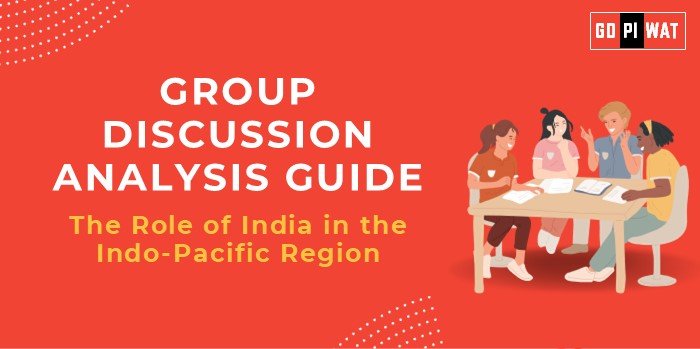📋 The Role of India in the Indo-Pacific Region
🌐 Introduction to the Role of India in the Indo-Pacific Region
- 💡 Opening Context: The Indo-Pacific is a region of immense geopolitical and economic significance, acting as a hub for global trade, security, and technological innovation. India’s position, straddling the Indian Ocean and connecting Asia with Africa, underscores its crucial role in shaping the region’s future. For B-school aspirants, understanding India’s involvement offers lessons in strategic planning, diplomacy, and economic leadership.
- 🌍 Topic Background: India’s Indo-Pacific policy revolves around fostering inclusivity, economic growth, and a rules-based international order. The region, encompassing major global powers like the U.S., China, Japan, and Australia, faces challenges such as maritime security, trade imbalances, and climate change. India’s “Act East Policy” and active participation in Quad initiatives illustrate its commitment to the region.
📊 Quick Facts and Key Statistics
- 🌏 Global Trade Contribution: Over 60% of global trade passes through the Indo-Pacific, highlighting its centrality to global commerce.
- 💰 India’s Economic Trade with ASEAN: $110 billion in 2023, showcasing growing economic interdependence.
- ⚓ Naval Exercises: India participates in over 15 naval exercises annually in the Indo-Pacific, ensuring regional stability.
- 🛰️ Maritime Domain Awareness: Satellite-based surveillance covers 3.2 million sq. km.
👥 Stakeholders and Their Roles
- 🏛️ Government of India: Develops maritime infrastructure and policy frameworks for the Indo-Pacific.
- 🌐 Regional Organizations (ASEAN, BIMSTEC): Act as platforms for collaboration and conflict resolution.
- 🤝 Quad Members: Strengthen collective security and address regional issues like climate change.
- 💼 Private Sector: Invests in digital, maritime, and sustainable infrastructure.
🏆 Achievements and ⚠️ Challenges
Achievements
- 📈 Economic Engagement: Trade agreements with ASEAN and FTA negotiations with Australia and the UK.
- ⚓ Maritime Diplomacy: Leadership in SAGAR (Security and Growth for All in the Region).
- 🛡️ Security Alliances: Active role in Quad, Malabar Exercises, and bilateral defense partnerships.
Challenges
- ⚔️ Strategic Rivalries: Managing tensions with China in the South China Sea and along the LAC.
- 🏗️ Infrastructure Gaps: Need for greater investment in ports and connectivity.
- 🌊 Climate Vulnerabilities: Rising sea levels threaten low-lying islands and trade routes.
🌏 Global Comparisons
- 🇨🇳 China: Assertive maritime claims and Belt and Road Initiative investments challenge regional stability.
- 🇯🇵 Japan: Focuses on high-tech investment and disaster resilience.
📖 Case Studies
Seychelles: India funded a coastal radar project to enhance maritime security.
Indonesia: Partnered to develop Sabang Port near the Malacca Strait.
💬 Structured Arguments for Discussion
- Supporting Stance: “India’s strategic location and initiatives like SAGAR and Act East make it a pivotal Indo-Pacific player.”
- Opposing Stance: “India’s infrastructural and defense investments are inadequate compared to China’s Belt and Road Initiative.”
- Balanced Perspective: “While India has made significant strides in regional engagement, infrastructural and security challenges need urgent attention.”
🛠️ Effective Discussion Approaches
Opening Approaches
- 📊 Trade Statistics: Highlight India’s $110 billion trade with ASEAN to showcase economic engagement.
- 🤝 Quad Collaborations: Present examples of effective multilateralism to ensure regional stability.
Counter-Argument Handling
- 💡 “India’s diplomatic balancing between the U.S. and China demonstrates its strategic acumen.”
- 📈 “India’s growing defense budget reflects its commitment to strengthening regional security.”
📌 Strategic Analysis of Strengths and Weaknesses
Strengths
- 🌍 Strategic location at the crossroads of Asia and Africa.
- 🤝 Robust diplomatic ties and growing naval capabilities.
Weaknesses
- 🏗️ Infrastructure gaps hindering economic and security growth.
- 📉 Limited trade facilitation compared to regional competitors.
Opportunities
- 🌱 Partnerships in green technology and renewable energy.
- 🌊 Regional leadership in climate policy and disaster management.
Threats
- ⚠️ Rising regional tensions with China and other powers.
- 🌐 Economic disruptions from geopolitical conflicts.
🎓 Connecting with B-School Applications
- Real-World Applications:
- 📚 Insights into international business, operations management, and global strategy.
- Sample Interview Questions:
- 🤔 “How does India balance its economic and security priorities in the Indo-Pacific?”
- 💡 “What role does Quad play in India’s Indo-Pacific strategy?”
- Insights for Students:
- 📈 Study of Indo-Pacific policies enhances understanding of international market entry strategies.
- 🌍 Explore the role of global supply chain management in the region’s economic dynamics.


